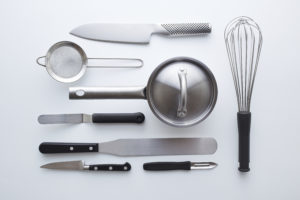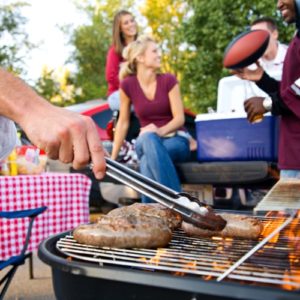As you progress through culinary academy, you will learn many advanced cooking techniques and master a variety of cuisines. However, one of the first steps in becoming an excellent chef is ensuring that you have the basic equipment you need at the ready. Here are nine of the most important tools for every chef to own:
1. Wooden spoons
Pick up wooden spoons in a few different sizes. These are essential for working on nonstick surfaces without damaging them. According to The Reluctant Gourmet, these utensils are easier on the hand than metal spoons. This is particularly relevant when preparing dishes that require extensive stirring, like a risotto. Also, unlike some metal spoons, wooden ones are non-reactive, so you can be confident they will not cause a metallic taste or surprising change in color when used to stir acidic ingredients.
2. Heat-resistant spatula
You will use a spatula for a number of kitchen applications, such as flipping burgers, folding over a batter and lifting baked goods out of the oven. That is why it’s a smart to have a selection of quality spatulas. Many spatulas melt or warp when exposed to high heat, so have at least one silicone model that is resistant up to 600 degrees Fahrenheit.
3. Thermometers
Having a cooking thermometer or two often comes in handy. At a glance, you can make certain your food is properly cooked and that you have conditions in your kitchen safely under control. It’s always a good idea to check the internal temperature of meat before removing it from the oven or stovetop. A deep fry or candy thermometer will allow you to keep tabs on oil simmering in a pot or skillet so you don’t need to use a deep fryer.
4. Dry and wet measuring cups
A chef develops strong instincts for the proportions of ingredients. Nonetheless, sometimes using precise quantities is necessary, especially in baking. Having two sets of measuring cups, one for wet ingredients and the other for dry, helps a great deal with getting those amounts right. Liquid measuring cups are designed to allow you to fill it to the line without overflowing, while dry cups let you easily sweep aside excess bits of solid ingredients. Moreover, as any good cook will attest, you will have greater control over how your dish comes out if you keep wet and dry ingredients separate until it’s time to heat them.

The sharp edges on these tools work exceptionally well for grating and shaping a variety of items, including cheese and hard spices like nutmeg. Michael Symon of “Iron Chef America” expressed his appreciation for his grater. “I can’t live without it,” he told Food Network Magazine. “Love the zest of citrus, freshly grated horseradish for a pop or a rich salty hard cheese.” They are available in several different sizes, so you can choose one best suited to a particular purpose.
6. Vegetable peeler
Being able to peel vegetables quickly and efficiently is important to preparing salads, soups or sauces. You may choose a Y-shaped or straight swivel peeler based on your preference. However, Serious Eats insisted upon the superiority of the Y-shaped peeler, which has a wider grip and can be used in either hand.
7. Whisk
Whisks in various sizes and shapes are invaluable for everything from preparing batter to mixing an emulsion. A straight whisk is suited to mixing and making sauce. The thin balloon whisk aerates cream or egg whites. Finally, a flat whisk works well for mixing a roux or deglazing a pan. Fine Cooking recommended looking for whisks with stainless steel wires that resist corrosion and a sturdy, sealed handle that won’t trap food inside.
8. Strainer
If you regularly cook great quantities of pasta, you need a large colander. Otherwise, a smaller, hand-held strainer may be preferable, giving you more control as you drain a pot and avoiding waste. As chef James Smith pointed out to Clean Eating, a strainer with a handle can double as a scoop when blanching vegetables.
9. Tongs
Perfect for flipping over a piece of chicken on the grill or a steak in a skillet, tongs are one of the most versatile kitchen tools. As ManMade expressed, when you are well-practiced at using a pair, they can become an extension of your fingers. Silicone-tipped tongs will stand up to high levels of heat and a spring-loaded handle will help you maintain a firmer grip on your food.



